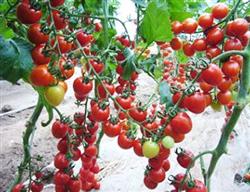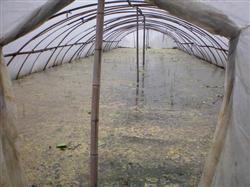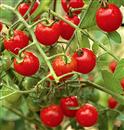Cultivation of cherry tomato in spring

Cherry tomato has high economic value and can be cultivated in spring in greenhouse. 1. Selection of varieties. Precocious varieties such as Jinzhu and Saint Virgin are selected. 2. Cultivate strong seedlings. The nutritious soil was prepared according to the proportion of 70% of vegetable garden soil and 30% of mature organic fertilizer, and then 5-10% human feces and urine, 0.1% compound fertilizer and 0.2% superphosphate were mixed well, and carbendazim solution was sprayed for disinfection. Each mu of field needs 3-4 square meters of seedbed and 5-10 grams of seeds. Soak the seeds in 1% potassium permanganate solution for 10 minutes before sowing, wash them with clean water and soak them in warm water for 6 hours, remove and drain water, wrap them with wet gauze, accelerate germination at a temperature of about 25 ℃, and sow seeds after exposure. The seedlings were raised in a nutrient bowl in the greenhouse from November to December, and the nutrient soil with a thickness of 0.5 cm was covered after sowing. Keep high temperature before emergence and pay attention to ventilation after emergence. The seedlings were pseudo-planted in sunny day and evening in the 2-leaf and 1-heart stage, and the root water was watered after pseudo-planting. After the pseudo-planting survived, the water content was controlled and the ventilation rate was increased appropriately to control the plant growth. The seedlings were refined 1-2 weeks before planting. 3. Land preparation and planting. From the end of February to early March of the following year, the land with no eggplant fruit vegetables, convenient drainage and irrigation, good ventilation and strong ability to conserve water and fertilizer was selected for planting. Deep trench high border cultivation, border width (continuous ditch) 1.3-1.4 meters, 6 meters wide greenhouse to make 4 beds. Combined with soil preparation, 4000-5000 kg of rotten farm manure, 1000-1500 kg of human feces and urine, 25 kg of superphosphate or 30 kg of compound fertilizer were applied per mu. The premise of planting is to buckle the shed early, fertilize and prepare the soil, spread plastic film and heat up. Two rows were planted in each border, with a distance of 40 cm and about 2500 plants per mu. After planting, the holes were sealed with wet soil, poured with sparse dung water, and built on a small arch shed. 4. Fertilization and watering. Sealed and insulated at the initial stage of planting. After slow seedling, the greenhouse temperature was kept at about 25 ℃ in daytime and above 10 ℃ at night. Ploughing and loosening the soil in time after survival to promote slow seedling. After slowing down the seedlings, the squatting seedlings were not watered to promote the root system. During the vigorous growth period, the soil moisture should be irrigated in time to keep the soil moist. Pay attention to drainage on rainy days. The soil should be cultivated properly in the later stage of plant growth. After the first ear is settled, the fertilizer is applied every 10 days, and the thin fertilizer is applied frequently, each time 20 kg of rotten cooked cake fertilizer or 10 kg of compound fertilizer per mu. 5. Set up a frame and prune. When the seedling is 30-40 cm high, the vine is tied, and the support is 2 meters high. Single culm pruning, leaving only the main branch, lateral branches with 1-2 leaves to top. Plant branches in the middle and later stage of growth, so that the middle and upper parts of the plant can grow normally and set fruit. 6. Flower and fruit management. There are 40-50 flowers per panicle and 30 fruits per panicle after fruit setting. When the temperature is too low or too high, spray the flowers with a solution with a concentration of 25-50 mg / kg. 7. Prevention and control of diseases and pests. Pay attention to the prevention and control of diseases and insect pests such as Botrytis cinerea, leaf mold, early blight, leaf miner and aphids. 8. Harvest. It is generally harvested from the end of April to early August. The varieties that are easy to crack can be harvested in advance, and the varieties that are not easy to crack can be harvested after changing color and ripening when they are not transported for a long distance. No stalk is left during harvest to avoid collision and squeezing of the fruit.
- Prev

Technical essentials of the new mode of "one kind of three harvests" of lotus root
Lotus root is an aquatic vegetable second only to Zizania caduciflora in cultivated area in our province. In recent years, with the popularization and application of protected cultivation technology, the harvest time of lotus root has been advanced to May-July, the market price has increased greatly, and the benefit is very significant. 1. Build a shed. Before setting up the shed, apply enough basic fertilizer and require the use of large and medium-sized.
- Next

Spring Seedling cultivation techniques of Cherry Tomato
Cherry tomato, also known as small tomato, mini tomato, table tomato, etc., its quality, flavor and nutritional value are better than ordinary tomato, and it has been very popular in the market in recent years. Now the spring open-field cultivation techniques are briefly introduced as follows: first, variety selection generally choose a string of red, red pearl, virgin, golden girl and other quality, good taste.
Related
- Where is it suitable to grow horseradish in China? it is expected to see the middle altitude horseradish in Alishan.
- How to prevent tomato virus disease reasonably? (Control methods included)
- Many people like to plant towel gourd on the balcony. What are the main points of this method and management?
- What crops can chili peppers be mixed with?
- Fertilization techniques and matters needing attention in Tomato
- What are the grafting techniques for peach seedlings in spring?
- Harm and control methods of root swelling disease of Chinese cabbage
- What are the pests of sweet potatoes? How to prevent and cure it?
- Symptoms, causes and Control methods of navel Rot in Tomato
- The cause of "Cucumber rotten bibcock" in Farmers' planting Cucumber and its Control Plan

